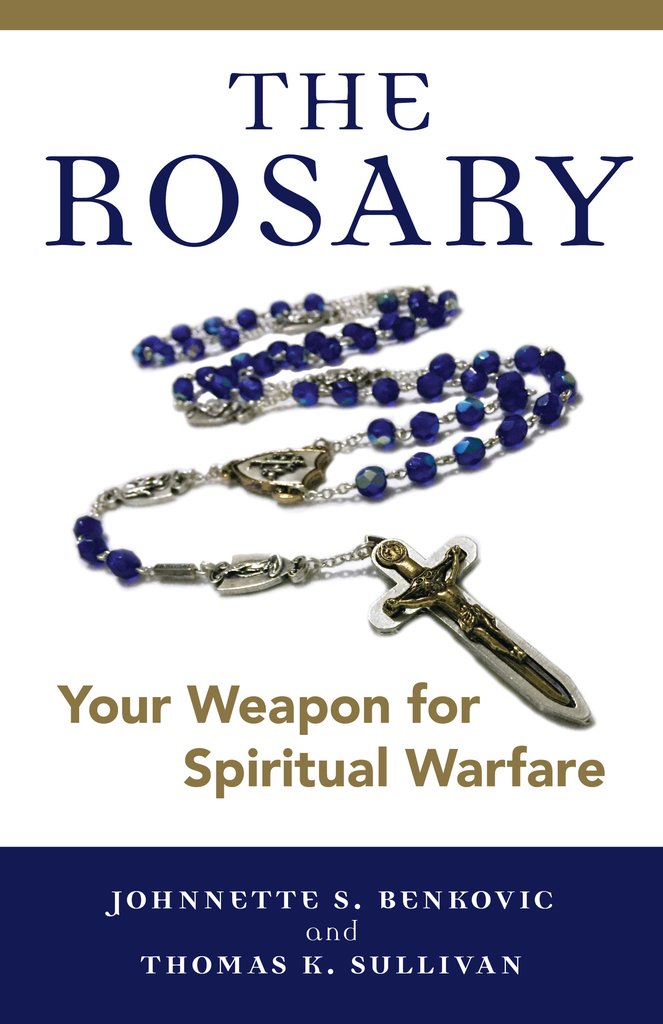For almost 800 years, the Order of Preachers has promoted the Rosary as a way to contemplate the life of Christ and grow closer to God through His Blessed Mother. In their new book The Rosary: Your Weapon for Spiritual Warfare, Johnnette S. Benkovic and Thomas K. Sullivan have teamed up to present a history and a guide for using the Rosary to grow spiritually as well as do spiritual battle in today's world.
[tweet "Using the Rosary to grow spiritually, do spiritual battle. Review by @CatholicMomVA @avemariapress"]
The book begins with a bit of history that goes back to The Fall. Written in a way that puts the reader right at the scene, the book details the Fall of mankind and the promise of a Savior, as well as a discussion about the Woman who will crush the serpent's head beneath her heel. This, of course, leads us to the Blessed Virgin Mary, who is that Woman.
In addition to the Scriptural lessons, The Rosary gives some theological background mainly by way of Pope St. John Paul II's Rosarium Virginis Mariae (but also including many of his other letters and teachings).
Perhaps my favorite part of this book was the collection of stories of saints and holy people who prayed and lived the Rosary in the world – from ancient times predating the actual Rosary up until the Twentieth Century. In three chapters, we are introduced to a total of 15 prayer warriors who used the Rosary as a tool for meditation and as a powerful spiritual weapon to change the world around them. First, we meet five men who lived the ideals of the Rosary, beginning with Saint Joseph, Terror of Demons. Next, we are introduced to five women who embodied the Rosary, beginning, naturally, with Our Lady of Guadalupe, Mother and Queen. Finally, we read about modern men and women, including St. José Sánchez del Río, a teenaged boy involved in the Cristeros movement almost a hundred years ago in Mexico. Each story highlights and illustrates a different way the Rosary affects our lives.
The book finishes with a call to action and a plan to follow to help bring more people to the devotion that John Paul II promoted, saying that he "entrusted any number of concerns" to it, and that he "always found comfort" there (RVM, 2; Bdenkovic and Sullivan, p. 41). The final chapter also contains instructions on how to pray a Rosary, making this an book that even non-Catholics (or Catholics who grew up without the Rosary) can implement.
Another of my favorite parts of this book were the individual stories of how the Rosary has impacted the lives of modern people. Each chapter contains one of these stories, from both clergy and laity. The stories help further demonstrate that this ancient devotion is truly evergreen and beneficial to our modern times. (Perhaps more than ever!) I would definitely recommend this book to any Christian who is seeking to deepen his spiritual life through prayer and meditation.
Be sure to check out our Book Notes archive.
Copyright 2017 Christine Johnson
Previously published at DomesticVocation.com
About the Author

Christine Johnson
Christine Johnson has been married to Nathan since 1993 and is the mother of two homeschool graduates. She and Nathan live in the Blue Ridge Mountains of Southwest Virginia, where she tries to fit in as a transplanted Yank. She blogs at Domestic Vocation about her life as a wife, mother, and Lay Dominican.




.png?width=1806&height=731&name=CatholicMom_hcfm_logo1_pos_871c_2728c%20(002).png)
Comments